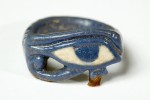RESPONSE #3 James Paz
I am an imposter. The last 100 Hours meeting brought home to me the ‘everydayness’ of the Egyptian ancestor bust – a quotidian quality from which my own life is disconnected. I have written previously about my lack of knowledge about my object, but this extends to applied knowledge too. What am I meant to be doing with it? How am I meant to be using it? In various ways, the ancestor bust would have shaped, and been shaped by, the lived experiences of people from the past. Someone crafted it. How can I ever learn what it was like to see and feel this thing taking shape before my eyes or within my hands? Someone, perhaps many people, owned it and lived with it. What happens to an anthropoid bust when you walk past it, perhaps talk to it, day in and day out? Does it remain a mysterious and powerful guest or does it become a more mundane member of the family?
Gaps in belief must be taken into consideration here also. It is one thing to share working or living space with an ancestor bust but another to genuinely, wholeheartedly, believe that it can speak – or that your ancestors can speak to you through it. I have written a 100,000 word thesis on Anglo-Saxon ‘things that talk’ but am I really any closer to believing that mere matter can communicate? In her introduction to Things that Talk, Lorraine Daston admits that sceptics will dismiss talk of talking things as metaphoric at best and, at worst, as a childish fantasy about ‘tongues in trees and books in brooks’. She highlights the two opposing ways in which, historically, things have been said to talk for themselves. On the one hand, the idol that makes portentous pronouncements to the devout who consult it but over which an air of fraud and folly hangs: in Antiquity it was suspected, often accepted, that a demon might masquerade as an effigy of a god – or that a priest might hide in the temple basement and whisper through hidden tubes. On the other hand, the thing that self-evidently speaks the unquestionable truth: from early modern legal codes where a bloody sword or the pallor of a pregnant woman could be taken as proof, to Christian miracles that manifested themselves in a wounded body or in water turned to wine.* It is therefore wrong to assume that historical persons were any more naive when it came to the talkativeness of things, the meaningfulness of matter; yet clearly the perspectives of the past are always informed by varied and complex belief systems – belief systems it may be impossible to replicate in twenty-first-century London.
Is there a way to resist imposing myself – myself as a socially and culturally constructed subject – onto this object? Is there a practical way to bridge these gaps in knowing and doing and believing? As I look ahead to the kind of ‘essay’ I want to write for the 100 Hours project, I wonder what kind of prose, what kind of form, what kind of book, might facilitate this.
* See Lorraine Daston, ed., Things that Talk: Object Lessons from Art and Science (New York: Zone Books, 2008), pp. 12-13.


Glad I’m not the only one feeling like an impostor with my object James! But then I think it could also be useful. We could get gloriously postmodern?!